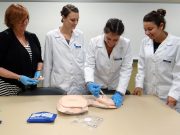Addiction rehab organization Narconon warns parents that a heroin epidemic may be coming to their backyards soon, as heroin replaces prescription opiates for many addicts.
For a decade, organizations like the US National Institute on Drug Abuse (NIDA) have been issuing reports on the growth in prescription drug abuse. Since the 1990s, they report, prescription drug abuse has grown by leaps and bounds, with opioids leading the way. When all the figures were received on 2007 deaths from drugs, it was discovered that prescription drug deaths had quadrupled between 1999 and 2007 and in fact, exceeded the number of deaths from heroin and cocaine combined.
In its latest edition, the National Survey on Drug Use and Health estimates that 6,600 Americans begin to abuse prescription drugs each day, and that a third of these are youth between 12 and 17 years of age. The 2010 Monitoring the Future report on substance abuse by teens noted that Vicodin and OxyContin (hydrocodone and oxycodone) were among the top prescription drugs being abused by teens. Only marijuana was being abused more often.
It was expected that these high levels of prescription drug abuse would result in increases in request for prescription drug addiction treatment, and at Narconon drug rehabilitation centers in different parts of the US, intake information seemed to indicate more and more people arriving for help with prescription drug addiction.
But now, there are signs that this pattern may be replaced by a new one in which heroin is a leading player in deaths and addiction. As Prescription Drugs Get Harder to Come by, Heroin May be Taking its Place.
If you look at them one by one, the news reports on increased heroin activity may not be startling. Newspapers in various corners of the country have been recently running stories on the increases seen in heroin seizures, requests for heroin withdrawal treatment or overdose deaths. But when you connect the dots, the larger pattern is seen.
Take these stories, for example:
In March 2012, the Chicago Tribune reports a heroin epidemic in the suburbs after there were six heroin deaths in 2011 in Naperville. Those who died were aged 17 to 30. DuPage had an increase in heroin seizures from 16 in 2008 to 59 in 2011. King County, Washington health officials alerted the public to an unusual increase in heroin deaths – seven in just a few days, whereas six months in 2011 had seen 32.
Central Michigan law enforcement reported an increase in heroin abuse in Ionia, Montcalm, Newagyo and Mecosta Counties as reported by the Michigan news website www.mlive.com.
And in San Diego, the 10News Team reported that heroin use among young adults in the county were skyrocketing, with 219 young people admitted to addiction treatment for heroin in 2007 and 721 admitted in 2011.
Some of these news reports make the connection between the change in prescription drug laws and this increase in heroin use. One by one, US states have been implementing tracking systems to detect people going from pharmacy to pharmacy to get opiate prescriptions filled, and changing prescribing laws to block over-prescribers.
Florida made a couple of key changes in the laws that were implemented in 2011 that resulted in oxycodone purchased by doctors falling 97% in very short order, as reported in the New York Times. This change meant that prescription drug dealers from Kentucky, Tennessee and other states would have to go elsewhere than Florida for their drugs. And while these new drug distribution centers certainly will exist – some reports indicate Cincinnati and Houston may be new source cities – slowly the noose is being tightened around the suppliers’ necks.
While the euphoric mood created by heroin is said to be similar to that of prescription opiates, heroin comes with its own set of special problems.
First among these issues is the uncertain potency, said to be the possible cause behind the rash of King County deaths. NIDA also reports that toxic contaminants or additives can have their own destructive effect, clogging blood vessels in the lungs, kidneys, liver or brain. This blockage can cause permanent damage to these and other organs.
“If family members have any suspicion that a loved one is abusing prescription drugs, especially opioids, the right time to get them help is now, before they can switch to heroin,” advised Clark Carr, the president of Narconon International. In fifty locations around the world, Narconon drug and alcohol rehabilitation centers guide addicts through the process of achieving lasting sobriety.
“The Substance Abuse and Mental Health Services Administration reported that an average of fifteen years pass between the first substance abuse and first admission to treatment,” Mr. Carr added. “If a family can get a loved one into treatment in a shorter time, they can help that person avoid enormous physical and mental damage and perhaps even save his life. When Narconon is the choice for addiction recovery, 70% of those graduating from this program will find lasting sobriety. This means thousands of people worldwide who never need to go to rehab a second or third time to maintain recovery.”























